
Battles and Campaigns
|
|
Swedish Polish War 1600 to 1609 1601 Spring Summer Campaign (2) The Battle of Kokenhausen (23 June 1601) On the approach of the Swedes, Radziwill left 500 infantry in entrenchments opposite the town under Otto Denhoff, who had orders to maintain fire on the town. 150 men guarded the camp, and with the rest he entered the field of battle. His force comprised around 3,000 men, of which some 400 were infantry with 9 canons. Gyllenhjelm, with 900 infantry and his artillery, occupied a ruined farm in the centre of his formation and commenced its fortification. He placed 2,000 cavalry on each wing, with about 1,200 horse in each first line. To protect his right flank he positioned a line of wagons. The Poles and Lithuanians arrived on the field of battle once the Swedes had formed up and Chodkiewicz sent out some hundred skirmishers to cover the deployment of his forces:-
(B) In the second line were two regiments of 300 horse each, on the right Christopher Dorohostajski, on the left Stabrowski. (C) The Huf Walny in the third line was the Royal Grand Lithuanian Hetman's own forces (1,000-1,200 men, including 400 infantry) positioned on the highest ground from which the whole battlefield could be seen.
The Swedes also deployed a similar number of skirmishers to counter the Polish-Lithuanian skirmishers. Radziwill, observing the Swedes with both flanks protected either by the Dwina or the forest and wagons, decided to break them on his right wing. He ordered both his first lines to attack the Swedish left wing sending almost half his army. He had no intention of opposing the immobile enemy infantry. While the Swedish right wing was to be tied up by Stabrowski assisted by 200 infantry and 5 cannons. In reserve Radziwill left some 800-1000 men and 4 cannon.
It took some time for Radziwill to collect his tired units after their pursuit and strike the infantry. The cavalry failed on the pikes and musket fire. It was only after the arrival at about noon of the Polish-Lithuanian artillery that their resistance was broken. Most of the infantry were killed.
The Battle was won by powerful hussar charges. Where this battle differs from many others in this period was the high economy of strength utilised. The decisive point for the battle was selected and there half the army was directed while the enemy centre was completely ignored. The importance of a powerful reserve cannot be underestimated and its large size was also exceptional for this era. Following the battle the worn out garrison of Kokenhausen capitulated while the Swedish siege artillery, which included six large cannons, was captured. |
|
![]()
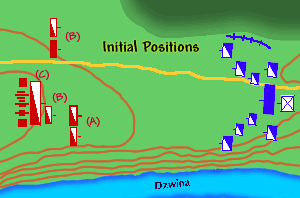 (A)
The first line was composed 1,000 horse commanded by Chodkiewicz.
They comprised two regiments - Chodkiewicz's own and Radziwill's.
(A)
The first line was composed 1,000 horse commanded by Chodkiewicz.
They comprised two regiments - Chodkiewicz's own and Radziwill's.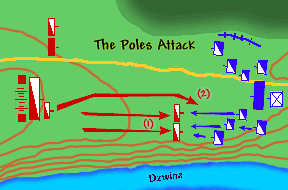 At
just after 7:00, on seeing the size of Polish-Lithuanian forces
forming up against his left wing, Gyllenhjelm reinforced this wing
with his skirmishers. With the lack of a reserve it was the only
way to strengthen them. Shortly after being struck by both of Chodkiewicz's
regiments the left Swedish wing became disorganised but were soon
supported by the second line. At this point the Swedes had a numerical
superiority (2,000:1,300) and the Poles and Lithuanians were checked.
Soon however Dorohostajski's unit quickly passed the weak fire of
the infantry and artillery and struck the engaged Swede's flank.
The force of the attack and its location ensured the collapse of
the Swedish horse who routed and their pursuit began.
At
just after 7:00, on seeing the size of Polish-Lithuanian forces
forming up against his left wing, Gyllenhjelm reinforced this wing
with his skirmishers. With the lack of a reserve it was the only
way to strengthen them. Shortly after being struck by both of Chodkiewicz's
regiments the left Swedish wing became disorganised but were soon
supported by the second line. At this point the Swedes had a numerical
superiority (2,000:1,300) and the Poles and Lithuanians were checked.
Soon however Dorohostajski's unit quickly passed the weak fire of
the infantry and artillery and struck the engaged Swede's flank.
The force of the attack and its location ensured the collapse of
the Swedish horse who routed and their pursuit began. 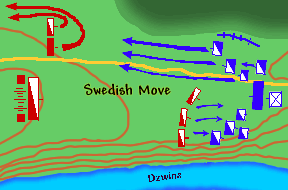
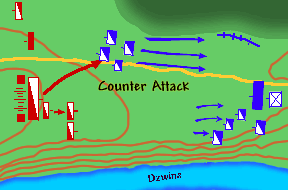
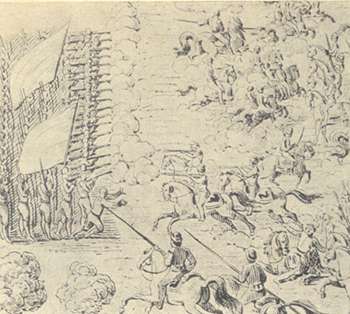 Overall
the Swedes lost 2,000, the Poles and Lithuanians 200. Gyllenhjelm
managed to gather 2,000 cavalry some 14km from the battlefield and
wanted to return to Kokenhausen to help the infantry but his men
would no agree.
Overall
the Swedes lost 2,000, the Poles and Lithuanians 200. Gyllenhjelm
managed to gather 2,000 cavalry some 14km from the battlefield and
wanted to return to Kokenhausen to help the infantry but his men
would no agree.